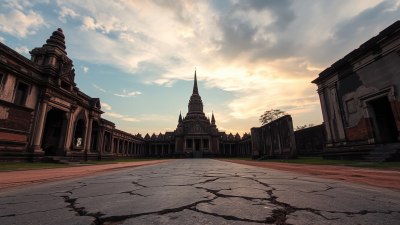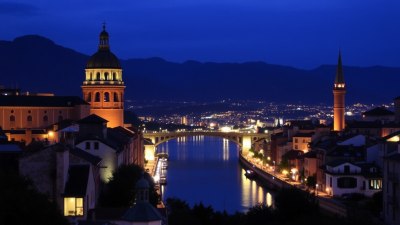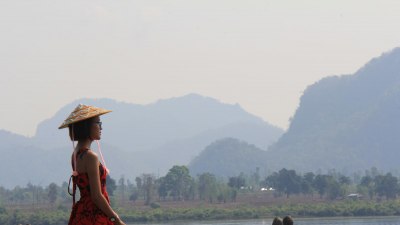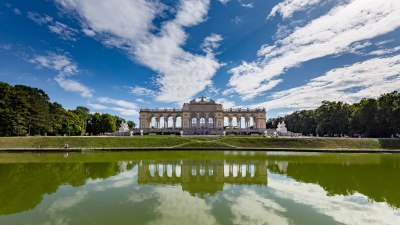The Cracks in the Road Remember in Ayutthaya, Thailand
Explore the historical echoes and modern reflections in Ayutthaya, Thailand's ancient city.

Image created with Flux Schnell
Ayutthaya, once the thriving capital of the Kingdom of Siam, holds a unique place in the annals of history. Its majestic ruins tell stories of a bygone era, echoing the grandeur and cultural richness that once flourished here. The crumbling structures and weather-worn roads of Ayutthaya serve as a poignant reminder of the passage of time and the resilience of history.
The city was founded in 1350 and became one of the largest urban areas in the world during the 18th century, showcasing a blend of Khmer, Sukhothai, and Persian architecture. The layout of the city was meticulously planned, forming an impressive network of canals and waterways that facilitated trade and transportation. As you stroll through the site today, the cracks in the road might whisper tales of bustling markets and diplomatic exchanges, reflecting the city's status as a melting pot of cultures.
The Great Temples of Ayutthaya
Among the notable sites in Ayutthaya are its temples, which once stood as the focal points of spiritual and community life. Wat Phra Si Sanphet, the largest and most important temple in the city, is a stunning example of the architectural grandeur of the era. It was originally built in the 14th century and served as a royal temple, housing the ashes of kings in its three iconic chedis. As you stand before these structures, imagine the rituals and ceremonies that would have filled the grounds with life and significance.
Another remarkable site is Wat Chaiwatthanaram, a temple constructed in the mid-17th century, embodying the Khmer architectural style. It was built by King Prasat Thong to honor his mother's home town, and its layout is a reflection of the cosmological beliefs of the time. The temple’s central prang symbolizes Mount Meru, the center of the universe in Buddhist cosmology, while its surroundings mirror the world of the gods above and the underworld below. The intricate designs on the temple walls and the serene atmosphere invoke a deep sense of reverence and connection to the past.
Archaeological Significance
The archaeological significance of Ayutthaya cannot be overstated. It was designated a UNESCO World Heritage Site in 1991, recognizing its outstanding universal value. Excavations and research continue to reveal insights into the life and culture of the people who thrived here. The artifacts uncovered—ranging from pottery to sculptures—provide a glimpse into the daily lives of the Ayutthaya inhabitants, showcasing their artistry, trade practices, and social structure.
Historically, Ayutthaya was known for its diplomatic relations with foreign powers, including the Portuguese, Dutch, French, and English. It is fascinating to note that the city had one of the first international ports in the region, where merchants would gather to exchange goods, ideas, and culture. The remnants of this vibrant commercial hub can still be felt today, with local markets and shops reflecting the rich culinary heritage influenced by diverse interactions over centuries.
Modern Ayutthaya: A Living City
While Ayutthaya is famed for its historical ruins, it is also a living city, bustling with activity and modern life. The juxtaposition of ancient architecture and contemporary life creates a unique atmosphere where tradition meets modernity. Local festivals often breathe new life into the old walls, as residents and visitors alike come together to celebrate the rich heritage through music, dance, and food.
The local cuisine is an emblem of Ayutthaya's cultural synthesis, with dishes that reflect the city's historical ties to diverse culinary traditions. Street vendors and restaurants serve up delectable meals, from the famous Ayutthaya boat noodles to various Thai desserts, inviting visitors to indulge in the flavors that have been passed down through generations. This culinary journey is a way to taste the history and the cultural exchanges that have shaped the region.
Preservation Efforts and Challenges
Preserving the historical integrity of Ayutthaya poses several challenges, particularly due to environmental factors and urban development. The city is located near the Chao Phraya River, and frequent flooding has led to the deterioration of some sites. In recent years, efforts have been made to protect these invaluable landmarks, including the restoration of certain temples and infrastructure improvements to manage the impact of flooding.
Moreover, initiatives aimed at promoting sustainable tourism are critical to balancing the needs of visitors with the preservation of cultural and historical sites. By raising awareness about the significance of Ayutthaya's heritage among tourists, local authorities hope to cultivate a sense of respect and responsibility, encouraging visitors to engage meaningfully with the city and its stories.
The Echoes of the Past
As you traverse the roads of Ayutthaya, take a moment to listen to the echoes of the past. The cracks in the pavement tell stories not just of deterioration, but of endurance, of a city that has weathered storms—literal and metaphorical—yet remains standing as a testament to human creativity and resilience. Each fragment of brick and ruin speaks not only of its own history but also of the lives that once surrounded it, each a thread in the rich tapestry of Ayutthaya’s narrative.
Visiting Ayutthaya is an invitation to reflect on the complexities of history and the lessons that remain relevant in our contemporary world. The city encourages us to appreciate the beauty of preservation, to engage with the past while forging new connections with the present. As we walk through its streets, we become part of the ongoing story of Ayutthaya, a story that continues to unfold amidst the echoes of history.
A Journey Through Time
In conclusion, Ayutthaya offers more than just picturesque ruins; it is a living museum, a vibrant reminder of Thailand’s past glory and cultural synthesis. The city challenges us to confront our understanding of history, to find relevance in the lessons it imparts, and to respect the legacy of those who came before us. As we navigate the cracks in the road, we are invited to not only observe but also to remember, honor, and celebrate the rich heritage that is Ayutthaya, Thailand.











